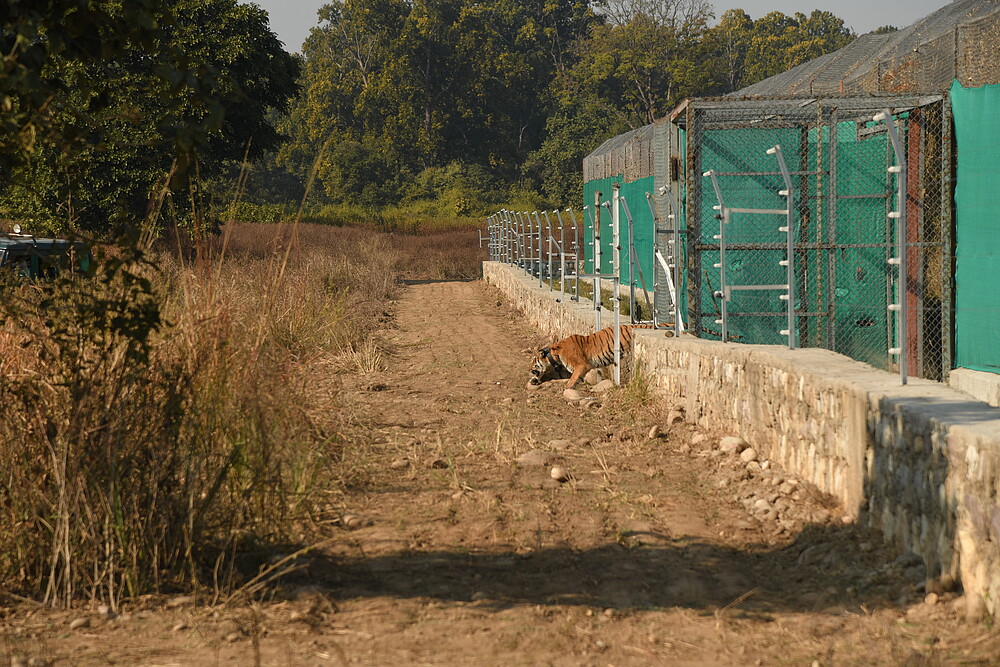There appeared to be little hope for tigers in the west of Rajaji Tiger Reserve until a landmark translocation plan to bring tigers back from the brink of extinction began in January 2021. But how exactly do you translocate a tiger?
Encompassing both India and Nepal the Terai Arc Landscape is a diverse region home to an incredible array of wildlife, including tigers. However the towns and cities in the landscape are constantly growing, putting increasing pressure on the natural areas which surround them.
Rajaji Tiger Reserve in the west of the Indian Terai Arc Landscape has seen this impact more than most. A growing city, railway line, and highway have sliced through the centre of the reserve making it near impossible for tigers to move between the eastern and western regions. There are estimated to be only two female tigers left in the western region and there have been no signs of breeding since 2006.
At the heart of any successful conservation programme is a team of dedicated people. Dr. Pranav Chanchani, the National Lead for Tiger Conservation at WWF-India, tells us what is involved when translocating this iconic big cat.
Where are the tigers being translocated from?
The tigers are translocated from Corbett Tiger Reserve which is roughly 200km east of Rajaji Tiger Reserve and has the world’s highest density of tigers.
Why is this translocation so important?
Infrastructure developments and urban growth have nearly severed the eastern and western parts of Rajaji Tiger Reserve. Tigers play an important role in ecosystems but their population has been severely depleted here. We’re hoping the translocation will ensure the recovery of a viable breeding tiger population. While translocation is important, to hold onto the progress we will need to restore the connectivity between the two halves of Rajaji Tiger Reserve.

How do you translocate a tiger?
The preparation for the translocation happens over a long period of time. In Rajaji, multiple agencies including the State Forest Department, National Tiger Conservation Authority, Wildlife Institute of India and WWF contributed to this effort
Tigers are being translocated from Corbett Tiger Reserve so their population has to be monitored over time to see which individuals could be moved. Planning and carrying out the capture operation takes time, mainly because tigers aren’t easy to catch. Once darted, the tiger is transported in a specially adapted cage which is designed to ensure there’s nothing the tiger can bite or claw into. It’s a good design!
In western Rajaji Tiger Reserve, where the tigers are being translocated to, we engaged communities in the programme, especially those who are in the translocation area. Baseline surveys were carried out of the area and prey numbers were monitored.
At the translocation site an enclosure was built to enable the soft release of the tiger (which lets it get used to its new surroundings and is then gradually released). A core team of 20 people have also been trained to track the tigers 24 hours a day, as well as the forest department who also supported the translocation and will protect these animals. Plans are also in place to monitor the translocated tiges, prey and their habitat over several years.
At both ends there is a dedicated team of veterinarians, biologists, conservation professionals and social scientists. It's a comprehensive effort to make sure the tiger, field teams and communities are as safe as possible.
How will the tigers be monitored after they’re released into Rajaji Tiger Reserve?
There are several ways to monitor the translocated tigers. Firstly the tigers are fitted with a radio collar before being released into the reserve. The collar pings signals to a satellite that are relayed to ground teams who are tracking the tigers 24 hours a day. However, typically only a few individuals are radio collared and tigers are also monitored using networks of camera traps. Other methods of monitoring include tracking their pugmarks and analysing genetic material extracted from fur or scat.
[Note: A camera trap is a camera that is automatically triggered by motion like the presence of an animal. They are used to capture images of wildlife with as little human interference as possible and individual tigers can be identified in the photos by their unique stripe patterns.]
How do we ensure communities are involved with this translocation and are able to raise their concerns throughout this process?
Prior to the project, there had been an engagement process with communities who live in the translocation area. We’ve also been working with communities in the corridor between the two halves of the reserve as this is another critical region within the landscape.
There are a few million people who live within a few square-kilometres of this tiger reverse. It’s a phenomenal amount of people. Groups within this population that are most likely to come into contact with or be affected by translocate tigers have been engaged through livelihood development, energy, education and conflict mitigation programs, but there isn’t a one size fits all solution. As the tiger population grows, our delivery of solutions, especially in the context of (human tiger) conflict, will need to be up to the mark so people aren’t left feeling vulnerable or otherwise adversely affected.
What are your hopes for the future of tigers in Rajaji tiger Reserve?
In eastern Rajaji Tiger Reserve the tiger population was severely depleted and is now thriving and supplying tigers to surrounding areas. I think western Rajaji has every bit of that potential. This is perhaps the most densely human populated landscape across the tiger's range and is one of the world's major food baskets with intense agricultural production. So if we can bring back tigers here we can do it anywhere, provided there is political will and social support.